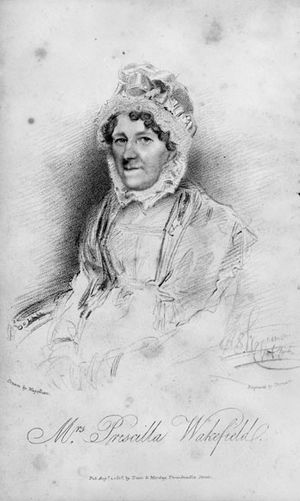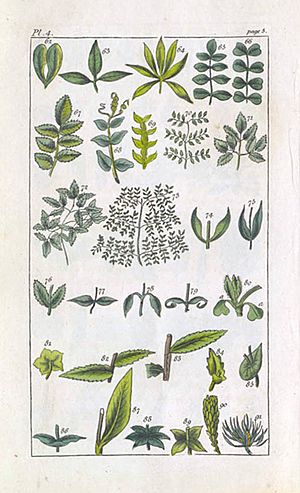Priscilla Wakefield facts for kids
Priscilla Wakefield (born January 31, 1751 – died September 12, 1832) was an amazing English woman. She was a Quaker who loved helping people. She also wrote many books, including ones about science, how women could be more independent, and fun non-fiction for children.
Contents
Priscilla Wakefield's Early Life and Family
Priscilla Bell was born in 1751 in Tottenham, a village near London. Her family was well-known. Her mother's grandmother was Robert Barclay, a famous Quaker writer. Priscilla had several sisters. One of them, Catherine Bell, married John Gurney. Their daughter, Elizabeth Fry, became a very famous social reformer.
Her Quaker Beliefs and Lifestyle
As an adult, Priscilla remained a member of the Society of Friends, also known as Quakers. She followed their religious practices. However, she didn't follow all their strict rules about clothing or avoiding fun activities.
Marriage and Children
Priscilla married Edward Wakefield (1750–1826), a merchant from London. They had three children who lived to be adults. To help support her family, Priscilla wrote 17 books over 20 years. She was one of many English women writers in the late 1700s who wanted women to have more opportunities in life.
Her Later Years
Priscilla Wakefield passed away on September 12, 1832. She was at her daughter Isabella's house in Ipswich. She was buried in the Quaker burial ground there. A painting of Priscilla, her husband, and her sister Catherine can be seen in South Kensington.
Priscilla Wakefield's Writings
Priscilla Wakefield wrote books on many different topics. These included natural science, ideas about women's roles, and economics. She also wrote many books especially for children.
Books About Women's Roles
In 1798, Wakefield published a book called Reflection on the Present Condition of the Female Sex; with Suggestions for its Improvement. This book looked at how women could earn their own money. She believed women should have better education. However, she thought this education would mainly help them be better wives and mothers.
Pioneering Children's Science Books
Priscilla Wakefield was well-known for writing helpful guides for children. Her early book, Juvenile Anecdotes, Founded on Facts, was very popular. She then wrote other books that were more advanced, covering science and travel. She was actually the first woman to write science books specifically for children!
She knew a lot about botany (the study of plants) and natural history. In 1796, she published a very popular book called An Introduction to Botany, in a Series of Familiar Letters. It was even translated into French. Later, she wrote An Introduction to the Natural History and Classification of Insects, in a Series of Letters. By the time she died, Priscilla Wakefield had written two dozen books. Many of them were printed multiple times and translated into other languages.
Selected Works by Priscilla Wakefield
- Mental Improvement: Or, the Beauties and Wonders of Nature and Art, 1794
- An Introduction to Botany, in a Series of Familiar Letters, 1796
- Juvenile Anecdotes, Founded on Facts, 1795-8 (two popular books)
- Reflections on the Present Condition of the Female Sex, With Suggestions for Its Improvement, 1798
- The Juvenile Travellers: Containing the Remarks of A Family During a Tour Through the Principal States and Kingdoms of Europe, 1801 (her most popular storybook)
- Domestic Recreation: Or, Dialogues Illustrative of Natural and Scientific Subjects, 1805
- An Introduction to the Natural History and Classification of Insects, in a Series of Letters, 1816
Priscilla Wakefield's Philanthropy
Priscilla Wakefield was very active in helping others. She supported education, helped pregnant women, and created savings banks for people in Tottenham who didn't have much money.
Helping Mothers and Babies
In 1791, she started the Lying-in Charity for Women. This charity helped poor pregnant women. It provided them with care during childbirth, some basic baby clothes, and a small amount of money. This charity continued helping families for many years.
Supporting Education for Girls
In 1792, she helped start the School for Industry. This school taught girls important skills like reading, writing, sewing, knitting, and arithmetic.
Creating Savings Banks
In 1798, Priscilla founded England's first "frugality bank." This bank helped people with low incomes save money. Members would pay a small amount each month. This money would then give them a pension after they turned 60 or help them if they became sick. Women and children were encouraged to save whatever they could. Many similar savings banks were set up across the country because of her idea.
Legacy
Priscilla Wakefield House, a nursing care home in Seven Sisters, London, is named after her.
- Portraits of Priscilla Wakefield at the National Portrait Gallery, LondonLua error in Module:EditAtWikidata at line 29: attempt to index field 'wikibase' (a nil value).
- Aindow, Rosy. "Priscilla Wakefield (1751–1832)". The Literary Encyclopedia. Ed. Robert Clark, Emory Elliott and Janet Todd.



